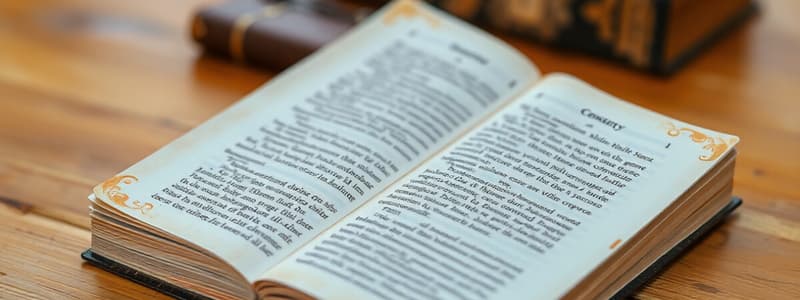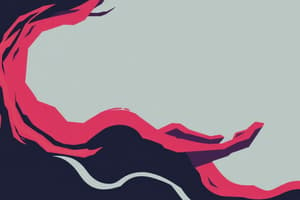Podcast
Questions and Answers
Which of the following is an example of Person vs. Nature conflict?
Which of the following is an example of Person vs. Nature conflict?
- A character getting hit by a tsunami (correct)
- A character struggling with guilt
- A character fighting against an evil AI
- Two friends having a misunderstanding
The first-person point of view allows readers to gain insight from multiple characters' perspectives.
The first-person point of view allows readers to gain insight from multiple characters' perspectives.
False (B)
A character struggling with guilt represents the ________ conflict.
A character struggling with guilt represents the ________ conflict.
Person vs.self
Match the following narrative elements with their examples:
Match the following narrative elements with their examples:
Which narrative point of view creates intimacy with the character and the reader?
Which narrative point of view creates intimacy with the character and the reader?
In second-person point of view, the narrator uses 'I' and 'we' to tell the story.
In second-person point of view, the narrator uses 'I' and 'we' to tell the story.
What is the main difference between a protagonist and an antagonist?
What is the main difference between a protagonist and an antagonist?
What is the primary role of the protagonist in a story?
What is the primary role of the protagonist in a story?
A flat character typically undergoes significant change throughout the story.
A flat character typically undergoes significant change throughout the story.
Define 'Climax' in the context of storytelling.
Define 'Climax' in the context of storytelling.
The literary device that involves giving human characteristics to non-human objects is called ______.
The literary device that involves giving human characteristics to non-human objects is called ______.
Match the type of irony with its correct definition:
Match the type of irony with its correct definition:
Which of the following is a type of figurative language?
Which of the following is a type of figurative language?
What is an inciting incident?
What is an inciting incident?
Alliteration is the use of exaggerated statements not meant to be taken literally.
Alliteration is the use of exaggerated statements not meant to be taken literally.
Flashcards
Person vs. Person Conflict
Person vs. Person Conflict
The struggle between a character and an outside force, such as another person, nature, or society.
Person vs. Self Conflict
Person vs. Self Conflict
The struggle within a character's own mind, such as dealing with guilt, fear, or doubt.
Person vs. Nature Conflict
Person vs. Nature Conflict
The struggle between a character and the natural world, such as a storm, a wild animal, or a harsh environment.
Person vs. Supernatural Conflict
Person vs. Supernatural Conflict
Signup and view all the flashcards
Person vs. Fate Conflict
Person vs. Fate Conflict
Signup and view all the flashcards
Person vs. Technology Conflict
Person vs. Technology Conflict
Signup and view all the flashcards
Person vs. Society Conflict
Person vs. Society Conflict
Signup and view all the flashcards
Protagonist
Protagonist
Signup and view all the flashcards
Antagonist
Antagonist
Signup and view all the flashcards
Flat/Static Character
Flat/Static Character
Signup and view all the flashcards
Round/Dynamic Character
Round/Dynamic Character
Signup and view all the flashcards
Exposition
Exposition
Signup and view all the flashcards
Inciting Incident
Inciting Incident
Signup and view all the flashcards
Rising Action
Rising Action
Signup and view all the flashcards
Climax
Climax
Signup and view all the flashcards
Study Notes
Exam Format
- Sight Passage (33 marks): Read a 3-page short story (unseen).
- Answer 8-10 questions in full sentences.
- Some questions may have multiple parts or use APEC/PPEC formats.
- Identify literary devices.
- Make text-to-self, text-to-world, or text-to-text connections.
- Review materials: Literary terms, story elements, figurative language list, and homework answers.
Part A: Terms and Definitions
Conflict Types
- Person vs. Person: A disagreement between characters (e.g., two friends arguing).
- Person vs. Self: A character's internal struggle (e.g., guilt).
- Person vs. Nature: A character facing natural forces (e.g., a tsunami).
- Person vs. Supernatural: A character confronting ghostly or mythical entities.
- Person vs. Fate: A character's battle against destiny.
- Person vs. Technology: A person struggling against an advanced technology, often malicious.
- Person vs. Society: A character opposing unfair laws or customs.
Narrative Elements
- Plot: A series of events unfolding, often a hero's journey.
- Setting: The environment of a story (e.g., a magical village).
- Character: The individuals in the story (e.g., a brave boy).
- Point of View: The perspective (e.g., first person using "I").
- Theme: An underlying message or idea.
Narrative Points of View
- First-person: The narrator is a character ("I," "we") - creates personal insight.
- Second-person: The narrator speaks to the reader ("You") - creates immersive engagement.
- Third-person omniscient: The narrator knows all characters' thoughts and feelings - comprehensive view.
- Third-person limited: The narrator knows only one character's thoughts and feelings - intimate connection.
Protagonist and Antagonist
- Protagonist: The main character, driving the story forward (e.g., a hero).
- Antagonist: The opponent of the protagonist (often a villain).
Character Types
- Flat/Static Character: Does not change throughout the story.
- Round/Dynamic Character: Undergoes significant change.
Plot Structure
- Exposition: Introduction of characters, setting, background.
- Inciting Incident: Event triggering the main plot.
- Rising Action: Building tension leading to the climax.
- Climax: The most intense point in the story.
- Falling Action: Events following the climax, leading to resolution.
- Resolution/Denouement: Conclusion, conflicts resolved.
Figurative Language
- Figurative language enhances writing by making comparisons.
- Examples: Metaphor (direct comparison), Simile (comparison using "like" or "as"), Personification (human qualities to non-humans), Hyperbole (exaggeration), Alliteration (repetition of initial consonant sounds), Onomatopoeia (sound words), Oxymoron (contradictory terms together), Idiom (a phrase with non-literal meaning), Symbolism (symbols representing ideas), Imagery (appealing to senses).
Irony
- Verbal Irony: Saying one thing, meaning another (sarcasm).
- Situational Irony: The opposite of what is expected happens.
- Dramatic Irony: The audience knows something the characters do not.
Studying That Suits You
Use AI to generate personalized quizzes and flashcards to suit your learning preferences.




